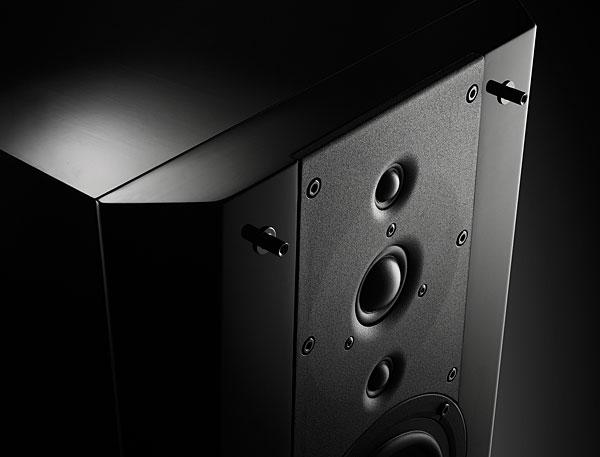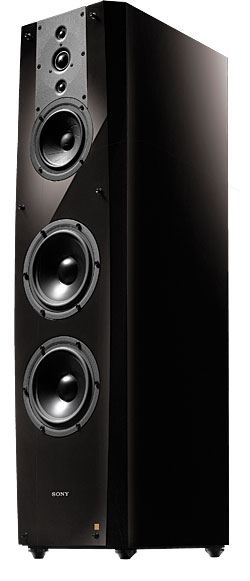| Columns Retired Columns & Blogs |
Sony SS-NA2ES loudspeaker

The door to a professional reviewer's listening room is one that revolves: As one product leaves, another enters. After a while, it becomes difficult to remember exactly when you auditioned any specific component. But some products stick in your memory—you fondly remember the time you spent with them, and wish they hadn't departed quite so quickly. With loudspeakers, I recall a few such: Revel's Ultima Salon2 ($22,000, footnote 1), MBL's 111B ($17,000), Dynaudio's Confidence C4 ($16,000), Sonus Faber's Amati Futura ($36,000), Vivid's B1 ($14,990), TAD's Compact Reference CR1 ($40,600 with stands), and even the much less expensive Harbeth P3ESR ($2195–$2395) and KEF LS50 ($1500). Among the most recently reviewed of those fondly remembered speakers is Sony's SS-AR2ES ($20,000).
Footnote 1: All prices are per pair and were those when these speakers were originally reviewed.
I was impressed by the SS-AR2. Somewhat mellow-balanced, it had a superlatively natural way with voices; clean, extended low-bass frequencies; and offered a transparent window on the recorded soundstage. So when, at the October 2012 Rocky Mountain Audio Fest, I first heard Sony's new SS-NA2ES speaker—which, at $10,000/pair, costs only half as much as the SS-AR2—I put it on my "to review" list.
The SS-NA2ES
The SS-NA2ES—"NA" stands for "Natural Acoustics"—appears very similar to the SS-AR2: a beautifully finished three-way tower, approximately 3' tall, with drive-units custom-made by Scan-Speak in Denmark and designed in collaboration with Sony: twin 6.5" aluminum-cone woofers and a 5" midrange unit with what looks like the same spiral radial cuts in its paper cone. (These cuts control the cone's out-of-band behavior to give a smooth low-pass rolloff above the crossover frequency.) The 'NA2 is actually a little more than 2" shorter than the 'AR2, however, and while those spiral cuts in the 'AR2's midrange were real, and subsequently filled with sealant in a time-consuming and expensive manual process, pressed into the new speaker's midrange cone are spiral radial grooves. (The drive-unit is exclusive to Sony.) The pressed grooves are not quite as effective as the filled cuts, but they allow Sony to keep the SS-NA2ES's bill of materials down.
The biggest external difference concerns the tweeter. Or tweeters. The 'AR2 had a conventional if high-quality, 1" silk-dome tweeter with a motor that featured a circular array of six neodymium magnets that left the rear of its diaphragm unobstructed. The 'NA2ES also uses a 1" silk-dome tweeter sourced from Scan-Speak, but mounts it vertically between two 0.75" fabric-dome "assist" tweeters. All three tweeters share the same faceplate and cover the same frequency range. I asked Sony's designer, Yoshiyuki Kaku, what he was trying to achieve with this three-tweeter array, which Sony calls the I-Array.
 Mr. Kaku explained that he'd been listening to a Sony "lifestyle" speaker, the Sountina, that had been developed by another group within the company. The Sountina had an unusual cylindrical tweeter with a 360° radiation pattern. Though the Sountina was not a "hi-fi" design, the sound of its tweeter was remarkably lifelike, and very different from that offered by normal directional dome tweeters. That experience set Kaku thinking about how he might get the same result from a conventional speaker, to widen its radiation pattern at high frequencies to better match that in the midrange and bass. The target was therefore to design a tweeter with a directivity similar to that of the midrange driver and woofers. Simply making the tweeter's dome smaller would increase the top-octave dispersion but compromise power handling. The solution turned out to be a vertical array of a single 1" tweeter flanked by two smaller-diameter tweeters, these having wider dispersion above 10kHz but slightly lower sensitivity. The benefit would be more top-octave energy in-room without affecting the flatness of the on-axis response.
Mr. Kaku explained that he'd been listening to a Sony "lifestyle" speaker, the Sountina, that had been developed by another group within the company. The Sountina had an unusual cylindrical tweeter with a 360° radiation pattern. Though the Sountina was not a "hi-fi" design, the sound of its tweeter was remarkably lifelike, and very different from that offered by normal directional dome tweeters. That experience set Kaku thinking about how he might get the same result from a conventional speaker, to widen its radiation pattern at high frequencies to better match that in the midrange and bass. The target was therefore to design a tweeter with a directivity similar to that of the midrange driver and woofers. Simply making the tweeter's dome smaller would increase the top-octave dispersion but compromise power handling. The solution turned out to be a vertical array of a single 1" tweeter flanked by two smaller-diameter tweeters, these having wider dispersion above 10kHz but slightly lower sensitivity. The benefit would be more top-octave energy in-room without affecting the flatness of the on-axis response.
I asked why this wouldn't introduce severe lobing in the vertical plane in the frequency region where the outputs of all three tweeters overlapped.
The answer: To ensure that the array would act as a single wide-dispersion tweeter without compromising the performance in the vertical plane, the distance between the main tweeter and the two assist tweeters had to be optimized, in conjunction with the shape of the frame and the depth of each diaphragm. A chance meeting in a local Starbucks with a colleague in Sony's R&D department proved fortuitous. The researcher had actually been working on ways of reducing fan noise in laptops, but was intrigued by the problem. He developed computer simulations of how spaced tweeters could work together without unwanted peaks and dips off axis. The solution involved making the shared front plate slightly concave so that the central dome would be recessed a little compared with the assist domes. (Sony has applied for a patent for this.) In conjunction with the spacing of the three tweeters, making the crossover point for the assist tweeters a little higher than that of the primary tweeter, and the assist tweeters' lower sensitivity, this would eliminate lobing in the vertical plane.
The tweeters' front plate is rabbeted into the top of the front baffle to give a smooth acoustic environment for the tweeter diaphragms. Like the SS-AR2, the 'NA2ES's enclosure is not designed to be completely inert; instead, its vibrational behavior is controlled in a manner consonant with the music. Like the 'AR2, the cabinet is made of Scandinavian birch ply, which has a dense grain structure. However, while the SS-AR2's enclosure has gracefully curved walls, the SS-NA2ES's cabinet is straight-sided, again to lower cost. Whereas the 'AR2's baffle was maple, the 'NA2ES's is also Scandinavian birch ply, 1.375" thick, with chamfered vertical edges to control lateral diffraction. Internal birch bracing is used to provide strategic stiffening. Although the wood is prepared in China, final machining and assembly of the enclosure, and overall manufacture, are performed at Sony's factory in Japan. The dark-brown gloss finish allows the wood grain to show through; the result is an elegant tower.
The twin woofers are reflex loaded with an offset, slightly flared port near the base of the rear panel. The midrange driver is mounted in its own internal chamber, isolated from the woofers' back pressure, and is vented with a small port just below the top of the rear panel. Electrical connection is via a single pair of high-quality binding posts on the rear panel, just above the port that loads the woofers. The speaker is supported by four small cones screwed into the base.
Listening
Like the SS-AR2s before them, the 'NA2ESes were set up in my listening room by Yoshiyuki Kaku, assisted by Sony Electronics' Motoyuki "Yuki" Sugiura. While this ensured that the speakers were optimally set up, I also continue to learn about speaker setup from observing others do it in a room that I know so well. I tried the SS-NA2ES with all three pairs of solid-state monoblocks I had on hand: Classé CTM-600s, MBL 9007 References, and Lamm M1.2 References (the Lamm's driver circuit includes a single small-signal tube). Like the YG Acoustics Sonja 1.3 loudspeaker, which I reviewed in July, the Sony proved fussy about which amplifier brought out its optimal performance.
Footnote 1: All prices are per pair and were those when these speakers were originally reviewed.
- Log in or register to post comments




































